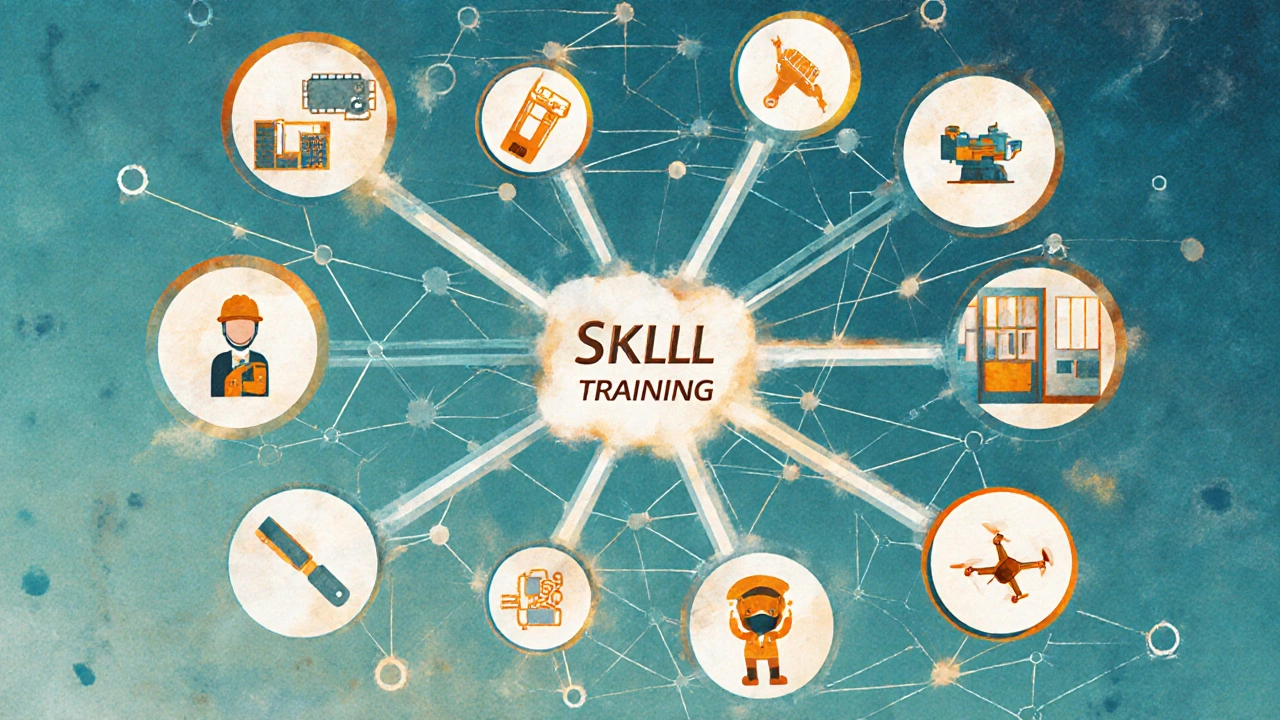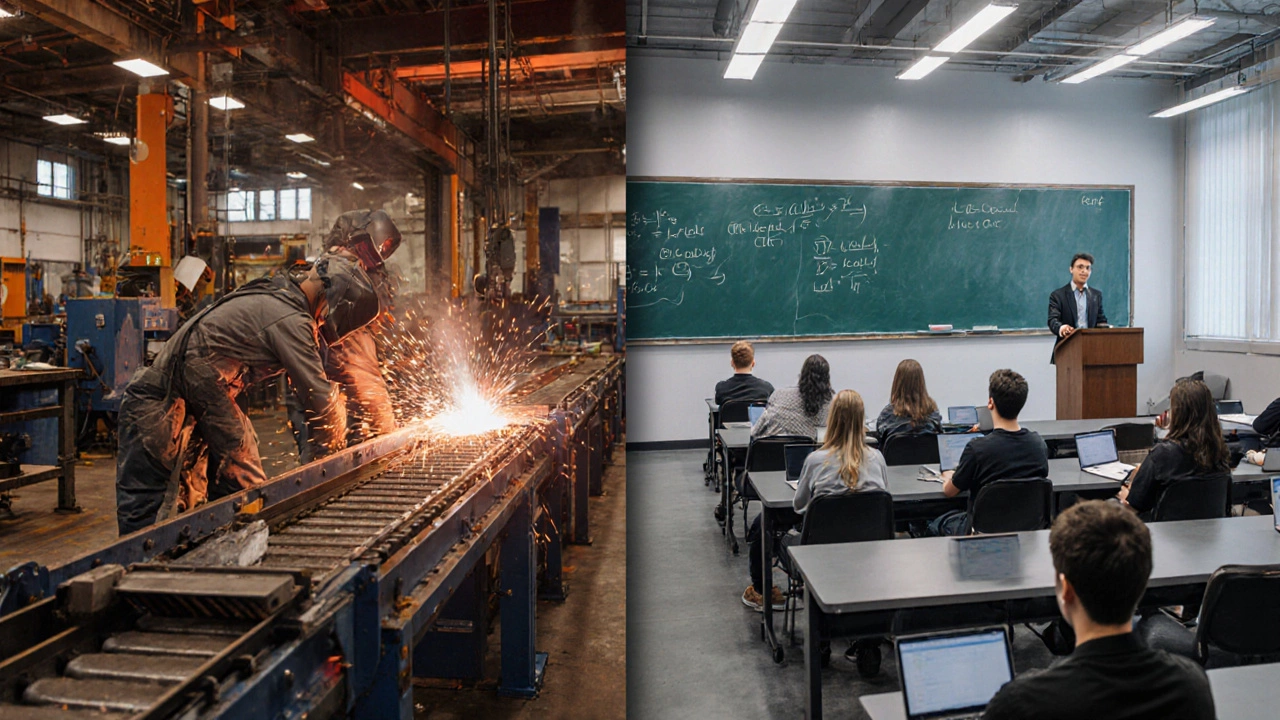Career Pathway Calculator
Find Your Best Path
Compare vocational education (CTE) with traditional college to see which path fits your goals
Select your preferences above to see your personalized comparison
If you’ve heard someone say "vocational education" lately, you might’ve thought it sounded old-fashioned. That’s because it’s not the term most schools, employers, or policymakers use anymore. Today, you’ll hear phrases like career and technical education, CTE, skills training, or even "workforce development." But what’s really changed - and why does it matter?
It’s Not Just a Name Change - It’s a Mindset Shift
The word "vocational" comes from the Latin "vocare," meaning "to call." It once meant training for a specific job - like welding, typing, or sewing. That’s still true. But the old label carried baggage: it was seen as a path for students who weren’t "college material." That stereotype is gone, and the new names reflect that.Today, career and technical education (CTE) includes robotics, cybersecurity, nursing assistants, graphic design, and even drone operation. These aren’t "backup" options - they’re high-demand careers that pay well and don’t require a four-year degree. In fact, over 60% of jobs in the U.S. now require some form of postsecondary training, but not necessarily a bachelor’s. CTE programs fill that gap.
What You’ll Hear Today - and What It Means
Here’s how the language has evolved, and what each term actually refers to:- Career and Technical Education (CTE): The most common official term in U.S. public schools and federal policy. It covers everything from auto repair to biotech lab tech. CTE programs are often tied to industry certifications - like CompTIA A+ for IT or OSHA 10 for construction safety.
- Skills Training: Used by community colleges, nonprofits, and workforce agencies. It’s focused on short-term, job-ready skills. Think: six-week courses in medical billing, HVAC repair, or culinary arts.
- Trade Schools: Still widely used, but now often called "career colleges" or "technical institutes." These are private or public schools offering certificates or diplomas in fields like plumbing, electrician work, or dental assisting.
- Workforce Development: A broader term used by governments and employers. It includes upskilling adults, retraining laid-off workers, and aligning training with local job needs.
- Applied Learning: A more academic-sounding term used in some high schools. It means learning by doing - building a website, running a student-run café, or fixing engines in shop class.
These aren’t just synonyms. They’re lenses. "CTE" is the system. "Skills training" is the method. "Trade school" is the place. And "workforce development" is the goal.
Why the Old Term Fell Out of Favor
Back in the 1980s and 90s, vocational programs were often tracked separately - students were sorted into "college prep" or "vocational" based on test scores or counselor recommendations. That system reinforced inequality. Students from low-income backgrounds were more likely to be steered into vocational tracks, even if they wanted to go to college.Today’s model is different. CTE isn’t a separate track - it’s woven into the curriculum. A student can take algebra, English, and a CTE course in digital media all in the same day. They graduate with both a high school diploma and a nationally recognized certification.
States like Texas, Tennessee, and Wisconsin now fund CTE programs with the same priority as college prep. The federal government renamed its main vocational law in 2018 - the Perkins V Act - to reflect this shift. It’s now called the Carl D. Perkins Career and Technical Education Act.
What’s Actually Taught in Modern CTE Programs
Forget typing pools and manual drafting. Here’s what real CTE looks like in 2025:- Healthcare: Certified Nursing Assistant (CNA), Medical Coding, Pharmacy Technician
- Technology: Cybersecurity Fundamentals, Network Support, Web Development
- Skilled Trades: Electrical Installation, Plumbing, Welding, Renewable Energy Systems
- Business & Services: Digital Marketing, Customer Service Analytics, Small Business Management
- Advanced Manufacturing: CNC Machine Operation, 3D Printing, Robotics Maintenance
- Creative Industries: Video Production, Graphic Design, Game Design
Many of these programs partner directly with companies. A student in a CTE automotive program might spend half their week at a local dealership, learning how to service electric vehicles. That’s not "vocational" - it’s real-world experience that leads to a job on day one after graduation.

How CTE Compares to Traditional College
| Feature | CTE / Skills Training | Traditional 4-Year College | |--------|------------------------|-----------------------------| | Time to completion | 6 months to 2 years | 4 years | | Average cost | $3,000-$15,000 | $100,000+ (public), $250,000+ (private) | | Job placement rate | 80-95% (varies by field) | 60-70% (for non-STEM majors) | | Typical credentials | Certificates, licenses, diplomas | Bachelor’s degree | | Debt after graduation | Often $0-$5,000 | Average $37,000+ | | Industry demand | High in healthcare, tech, skilled trades | Varies widely by major |CTE doesn’t replace college - it offers a different path. Many students start with CTE, then go on to earn an associate’s or even bachelor’s degree later. Others never go to college and still earn $50,000-$80,000 a year as licensed electricians, IT support specialists, or surgical techs.
Who’s Behind the Change?
It’s not just educators. Businesses are pushing for this shift. The U.S. Chamber of Commerce reports that 77% of employers struggle to find workers with the right technical skills. That’s why companies like Amazon, Siemens, and Home Depot now fund CTE programs directly.Community colleges have also transformed. They’re no longer just for students who failed high school. They’re hubs for adult learners, veterans, and career-changers. In Georgia, a 42-year-old factory worker can enroll in a 10-week CNC machining course - paid for by state grants - and walk out with a job offer.
What to Look For in a Modern Program
If you’re exploring options, here’s what matters:- Industry-recognized credentials: Does the program lead to a certification employers actually ask for? (e.g., CompTIA, AWS, NCCER, ASE)
- Employer partnerships: Are local businesses involved in curriculum design or hiring graduates?
- Hands-on labs: Can you actually work on real equipment - not just watch videos?
- Job placement data: Ask for the last year’s placement rate and average starting salary.
- Transfer options: Can credits count toward a college degree later?
Don’t be fooled by flashy websites. Ask: "Who hires your graduates?" If they can’t name three local employers, walk away.

Is This Just for High Schoolers?
No. In fact, the fastest-growing group in CTE programs is adults over 25. Whether you’re laid off, underemployed, or just tired of your current job, there’s a program for you.Programs like Year Up and Per Scholas offer free, intensive training in tech fields - with stipends and job placement. The U.S. Department of Labor funds over 1,200 such programs nationwide. You don’t need a high school diploma to qualify for some - just the willingness to learn.
Where to Find These Programs
Start here:- Your local public high school’s CTE office
- Your community college’s workforce development center
- State workforce agency websites (search for "[Your State] workforce development"
- Nonprofits like Goodwill, YMCA, or local chambers of commerce
- Government portals: CareerOneStop.org (U.S. Department of Labor)
Don’t wait for someone to tell you about these options. Go look. Most are free or low-cost, and many offer transportation help or childcare.
Final Thought: It’s Not About Labels - It’s About Outcomes
Whether you call it vocational education, CTE, skills training, or trade school - the goal hasn’t changed: prepare people for good jobs. The difference now is that these paths are respected, funded, and connected to real careers.If you’re looking for a way into a stable, well-paying job without six figures in student debt - this isn’t a backup plan. It’s the smartest move you can make.
Is vocational education the same as trade school?
Trade schools are one type of vocational education, but not all vocational education is a trade school. Today, vocational education is mostly called Career and Technical Education (CTE), which includes trade schools but also covers tech certifications, healthcare training, and digital skills programs - often offered in high schools and community colleges.
Can you get a good job with CTE without a college degree?
Yes. Many CTE graduates earn $50,000 to $80,000 a year without a four-year degree. Jobs like electricians, HVAC technicians, cybersecurity analysts, and surgical techs often require certifications or associate degrees - not bachelor’s degrees. The median salary for CTE-related jobs in 2025 is $58,000, according to the U.S. Bureau of Labor Statistics.
Are CTE programs only for people who struggle in school?
No. CTE programs attract students of all academic levels. Many high-achieving students choose CTE because they want hands-on work, faster entry into the workforce, or to avoid student debt. In fact, top-performing students in STEM fields often take CTE courses in robotics or coding to build real-world skills alongside their academics.
Is CTE only available in high school?
No. CTE programs exist at the community college level, through nonprofit organizations, and even online. Many are designed for adults - including veterans, displaced workers, and career changers. Some programs offer free tuition through state grants or employer partnerships.
Do employers value CTE credentials?
Yes. Employers in healthcare, IT, manufacturing, and construction actively seek CTE graduates because they come with proven skills and certifications. Companies like Amazon, Microsoft, and Caterpillar partner directly with CTE programs to hire graduates. Many certifications (like CompTIA or AWS) are industry standards - just as valuable as a degree in those fields.








0 Comments